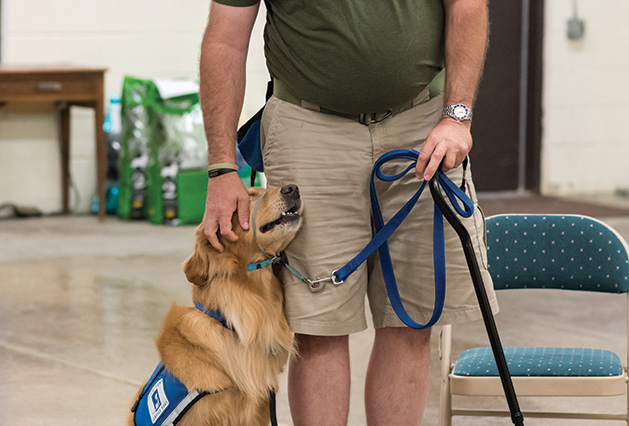
On a cold Friday last October, Hopkins High School was home to an unusual graduation. The typical footsteps made by pairs of loafers and heels making their way to the stage were replaced by the soft shuffle of furry paws. The ceremony marked the completion of the graduates’ training as service dogs and was put on by Helping Paws, a nonprofit based in Hopkins.
Helping Paws breeds and trains service dogs to be matched with people living with physical disabilities, as well as veterans and first responders affected by post-traumatic stress disorder. The organization celebrated 30 years of work last year and uses dogs to help those it serves have a higher quality of life and more independence. “The dogs can do all kinds of tasks, like open and close doors, retrieve items, take laundry out of a dryer, get something from a cupboard or go get help in another room,” says Helping Paws’ director of development Pam Anderson. “They’re not emotional support dogs, but I think all dogs intuitively provide emotional support and unconditional love—there’s no judging.”
Anderson, who has worked for Helping Paws since 2004, says the most rewarding part of her job is seeing the difference a service dog can make in the life of a recipient, helping them complete tasks and become more visible in society. Korb Schwietering, a Helping Paws service dog recipient, agrees. “When I got [service dog] Casper, I never imagined the kind of bond we would build,” he says. “With Casper’s assistance, I have attended Twins games, concerts, road trips and so many other outings that, previously, I had been unable to do … Casper has brought love and joy back into my life and I could not be more thankful.”
Dogs like Casper start their training at just 8 weeks old, when they are placed with volunteer foster trainers. They then come to class once a week for a period of 18 months to two and a half years. Helping Paws uses golden retrievers and Labradors in their work, and also runs the breeding program for these dogs. Dogs that just aren’t cut out for service work, mostly due to health problems, are often trained as therapy dogs and adopted by their foster families.
Once the dogs have completed training, they are matched with eligible individuals through a meet-and-greet process. The dog and its new owner will then go through a three-week training period to practice basic skills that includes field trips to places like hardware stores, grocery stores and walks on the street. Upwards of 80 service dogs are in training at any given time, and about 10 to 20 dogs are placed each year with recipients.
There are several ways for community members to get involved with Helping Paws, including volunteer opportunities in the office, on the board of directors, or at events. Over 95 percent of Helping Paws’ revenue is generated by fundraising, and anyone interested can make a donation on the website. As for volunteering to be a foster family and trainer of service dogs, Anderson encourages interested families to reach out. “Anyone can volunteer to be a foster and trainer; there are no special qualifications,” she says. “A lot of our volunteers say they came for the dogs, but stayed for the people.” Learn how you can lend a paw by clicking here.
Helping Paws
P.O. Box 634, Hopkins
952.988.9359









